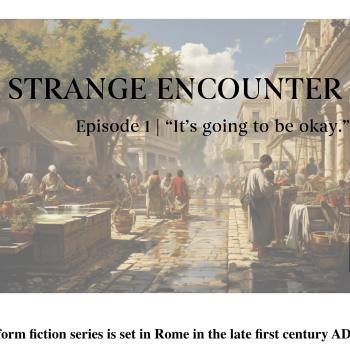 This is review #2 of a three part series looking at three new introductions to the NT (Boring, Hagner, Witherington). In the first installment, I gave attention to Boring (WJK). This round it is the volume by Donald Hagner called The New Testament: A Historical and Theological Introduction (Baker, 2012).
This is review #2 of a three part series looking at three new introductions to the NT (Boring, Hagner, Witherington). In the first installment, I gave attention to Boring (WJK). This round it is the volume by Donald Hagner called The New Testament: A Historical and Theological Introduction (Baker, 2012).
Let me say, before getting started, Hagner is one of my favorite NT scholars and an all-around great guy. I read his WBC work on Matthew in seminary and I have tracked his work on Paul for some time. Going into reading this book, I had pretty high expectations. I will say that this book did not disappoint.
- 1. How is the Book Organized?
This book of more than 800 pages is broken down into 8 sections (totaling 43 chapters).
Part 1: Introduction and Background (Church’s Scripture; OT story; world of the NT)
Part 2: The Gospels: The Proclamation of the Kingdom (Background and examination of the Gospels and Jesus)
Part 3: Acts: The Earliest Preaching of the Kingdom
Part 4: Paul and His Epistles: The Interpretation of the Kingdom
Part 5:The Deutero-Pauline Letters: Extending the Teaching of the Apostle
Part 6: Hebrews and the Catholic Epistles: Non-Pauline Christianity
Part 7: The Apocalypse: The Consummation of the Kingdom
Part 8: The Text and Canon of the New Testament
- 2. Is it Designed as a Textbook?
I would have to say “yes and no.” From the “yes” side, it is quite obvious this introductory book is pitched towards students trying to make sense of the New Testament. There are also textboxes located especially at the beginning of the chapters on NT books.
However, Boring’s text is much more “textbook-y” with its images and many charts and outlines. Hagner’s is a kind of hybrid – in many ways it reads like a regular book, but some accommodations have made to make it more user-friendly. Still, had the publisher put a bit more “pizzazz” into it, it could have been more clearly an option for introductory courses.
- 3. Does it Include any Hermeneutical and Canonical Discussions?
Not unlike Boring’s volume, Hagner’s book is sandwiched by some canonical and hermeneutical discussions. The first chapter gets into preliminary questions about how to approach the canon with both an eye to history as well as a life of faith. The final chapter gets into details regarding canonization.
- 4. What are the Key Interpretive Trends in the Book?
Hagner defends the ongoing need for good historical study of the New Testament against trends that focus solely on canonical-literary aspects. I think he makes a good case for this. Like Boring, he also invests time in dividing texts in terms of authentic authorship. However, even though he argues for a number of pseudepigraphical epistles, he does not think that this undermines the authoritative voice of these texts.
- 5. Is there a Wider “Theme” in the Book?
Even from the organization of the chapters, it should be clear enough that Hagner works with a salvation-historical approach that traces a story of redemption from the OT through the NT, particularly focused on the theme of the “kingdom of God.” At some points drawing this theme out can feel a bit strained (as with Paul as “interpreter of the kingdom”), but I think he should be commended for this effort and students will appreciate having a coherent approach to the Bible as a whole. All things being equal, I think this thematic coherence is a strength of his book.
- 6. Are Sectional Bibliographies Up-To-Date and Helpful?
As with my analysis of Boring’s text, so again I chose, as my case studies, looking at Romans and the Gospel of John.
In contrast to Boring’s approach (minimalist bibliographies), Hagner’s end-of-section recommended reading lists are quite exhaustive. For Romans, for example, Hagner lists over 100 recommended books and articles; and close to 50 commentaries. His list is up-to-date (including Matera’s 2011 Paideia volume), but it would have been helpful to have a choice few highlighted or starred so students would have a good guess as to where to begin.
Similarly, with the Gospel of John, Hagner’s bibliography is extensive (spanning 10 pages). It includes recent items like Ramsey-Michaels’ NICNT 2011 volume. Again, though, the quantity of information is a bit overwhelming.
- 7. Will This Book Appeal to Conservatives, Liberals, or Moderates?
I would put Hagner in a middle category, not unlike Boring. However, I think that Boring is towards the middle leaning left, while Hagner leans right. I don’t have a whole lot to prove that, but his salvation-historical paradigm has a “unity of the Bible” ring that would appeal to conservatives.
- 8. Is It Too Advanced in Terminology, Depth, and Method for Introductory Students?
I get the impression that, despite this book having a textbook-audience, it reads like a series of lectures (which is not a bad thing). That means that it doesn’t read like a reference work in the way Boring’s text does. I feel that, then, Hagner’s text is a bit more readable – something you would sit in an armchair in a coffee shop to read (though holding an 800-page book is not usually in that picture!).
As far as depth, my impression is that Hagner keeps it readable for introductory students. Average students at the seminaries that I have associations with would not find this book too difficult to read.
- 9. If A Student Wanted to Become Knowledgeable in the NT, would This Book Come to My Mind as a Recommendation?
I suppose I would recommend this book to someone who has already taken an introductory course. Once they have gotten a general feel of the NT, this book would be helpful for putting some of the pieces to together and ironing out questions of a Biblical-theological nature.
- 10. How Does This Book Stack Up Against Green/Achtemeier/Thompson, Powell, LT Johnson, and Carson/Moo?
I think Hagner’s work is in a category of its own. It is more “theological” than most of the other options. It would compete, I think, more with Howard Marshall’s New Testament Theology, perhaps offering the historical and background detail that does not appear in Marshall’s work. Right now, I am not slated to teach anything quite like a NT introduction, but if I were to teach such a course, this would be one of a small few books I would consider. Hagner does a pretty good job of separating the wheat from the chaff in terms of what is an absolutely central topic of conversation for introductory students. He manages to hit all of the key subjects that I would have wanted my seminary professors to deal with in terms of making sense of the NT.
Conclusion
Again, I don’t claim to offer an unbiased opinion – I think Hagner is a brilliant scholar. It is a privilege to have this major work from such a capable thinker and writer. In the few months I have had this book, aside from reading it for this review, I appealed to Hagner’s counsel in both lecture preparation as well as research for scholarly papers and articles. If you regularly get into theological discussions with your students, and you want a helpful evangelical voice, getting a copy of this book is a wise choice.











